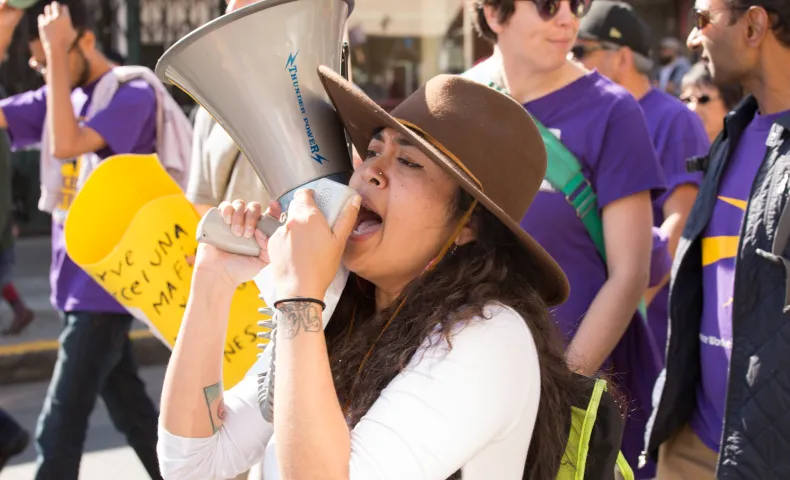 Photo by Molly DeCoudreaux Photography ©
Photo by Molly DeCoudreaux Photography ©
What Does It Take to Support Leadership and Effectiveness in Movements?
This article was originally published by the David & Lucile Packard Foundation.
The Haas, Jr. Fund recently convened two groups of grantees working on immigrant and LGBT rights in California. In the course of the conversations, leaders reflected on a range of tough challenges their organizations are facing in today’s charged political environment.
Considering that these social change groups are pressing hard to rapidly develop new advocacy campaigns, defensive strategies, and critical services for vulnerable communities, their urgent appeals for more unrestricted general operating support from funders came as no surprise. Less expected was that leaders also asked for targeted support to upgrade their capacity, infrastructure and systems so they can keep pace with the surge in activity and need.
For example, one ED said she has staff members who used to manage two people and who now need management training because they are overseeing teams of 10 or more. Other leaders talked about a surge in people offering time and money, but said they don’t have systems in place to effectively manage new donors and volunteers, let alone use the current moment as a way to build longer-term power and financial resilience.
Hearing from these leaders underscores the important role funders can play in simultaneously supporting movement capacity and organizational capacity. More specifically, we need to be more attentive to the interplay between the strength and agility of leaders and organizations and the dynamics of their broader movements. This means investing at two levels.
One: Investing In The Movement Organization
First, strong organizations are nearly always critical to strong movements, so investing in leadership and capacity building at the organizational level is essential. This is what the Packard Foundation does through its organizational effectiveness grantmaking, and it’s also what we do at the Haas, Jr. Fund through our Flexible Leadership Awards program.
Over the years, we’ve learned more about the particular leadership and capacity challenges that confront organizations working in movements. Though all nonprofit leaders must balance internal and external demands, today’s social change organizations are increasingly working in complex coalitions across issues, such as when an immigrant rights group joins with environmental and economic advocacy groups to advance a broader organizing or advocacy campaign. Executive directors working in multiple tables like these may need targeted support to develop triage and decision-making protocol that can help them prioritize requests on their time. And, with EDs spending more time externally, organizations need resources to develop strong senior teams that can carry more responsibility for internal operations and management.
Similarly, times like these call on boards to work differently. Instead of focusing on what’s best for the organization, boards will sometimes have to consider what’s best for the movement. For example, sometimes board members might be asked to approaching donors to contribute to an important campaign involving many groups even when that contribution could undermine their own organization’s annual gift. Again, this is probably not going to happen without an investment in board development that supports members to learn how to balance organizational and movement needs.
What does this suggest for funders? Unrestricted general operating support is vitally important, but it is not enough. We can’t put executive directors in the position of having to make a difficult choice between programs and the needs of their organizations. How can we help ensure that social change organizations have dedicated support to build the leadership and capacity they need to play powerful roles in advancing movements?
Two: Investing In The Movement
It’s also important to recognize that some leadership and capacity needs cannot be solved on an organization-by-organization basis; they have to be tackled at the movement level. This work can take a variety of forms. Examples include:
Supporting joint strategies. One approach is to invest in the capacity of movement leaders to co-create a macro game plan and strategic communications and messaging capacity. These are two essential capacities that social movements need to lead the development of the joint muscle and power for change. For example, this is what happened when a coalition of funders made it possible for 22 movement leaders to come together and craft a national game plan to achieve marriage equality state by state.
Building and strengthening networks. Another approach to building movement capacity is to support the conditions that lead to stronger collaboration and networks. A few years ago, for example, the Haas, Jr. Fund joined with Rockwood Leadership Institute to create a fellowship program for emerging leaders in California’s immigrant rights movement. The impetus for this year-long, intensive fellowship was not only to help individual participants develop key leadership skills, but also to help them build relationships in ways that could lead to a higher level of cross-movement collaboration.
Identifying gaps in movement leadership. Another fellowship we developed with the Arcus and Gill Foundations was aimed at addressing a gap in movement leadership among LGBT groups. Seeking to bring more people of color to the movement’s leadership ranks, the fellowships provide focused leadership development and networking support for people of color working in management positions at LGBT groups.
Helping leaders with challenges unique to their movement. Funders can also tailor support to help leaders with challenges that are unique to their movements. For example, the Novo Foundation recognized that many leaders of organizations that combat violence against girls and women, are themselves survivors of assault or abuse. So NOVO’s Move to End Violence initiative helps these leaders learn ways of dealing with trauma and self-care so they develop the resilience and capacity to assume more movement leadership.
It should not be a luxury for nonprofit leaders to find support to sustain themselves in the face of fierce opposition or to lead within their organizations and across movements. And it should not be a luxury for nonprofits working in movements to secure targeted support to build their capacity in core areas from getting strong boards in place to raising the resources to sustain their critical work.
Especially right now, with so much at stake for the social change movements that so many foundations support, we would be smart to listen to these leaders about what they really need—and to work as hard as we can to help their organizations and their movements succeed.
